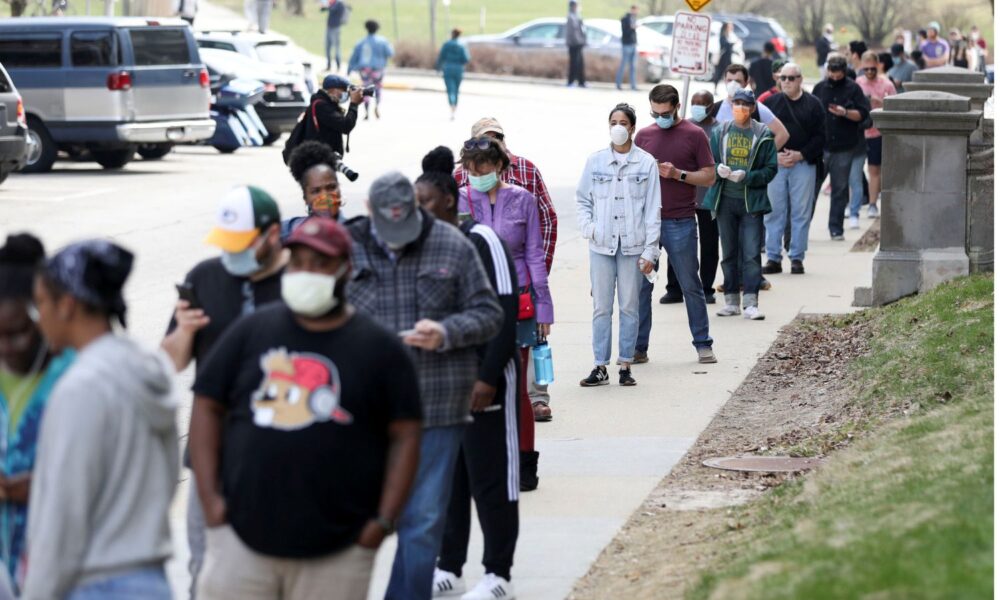Ahead of the 2021 Cleveland mayoral election, precinct captains working with our partner Greater Cleveland Congregations (GCC), a non-partisan organization of communities and partner organizations, organized voters in low-turnout precincts within the 1st, 2nd, 5th and 6th municipal wards. Organizing in a low-information electoral environment (an off-cycle local election) and targeting a sample of low-propensity (less frequent) voters, the GCC effort resulted in higher turnout among those contacted, and perhaps more importantly, laid the groundwork for future efforts to better engage and integrate voters who are often left behind in the electoral process.
Reaching out to voters
Beginning with a sample of approximately 1,900 registered adults who had not frequently participated in local elections, precinct captains and volunteers were able to verify current information for just over half (1,114). Although few organizers encountered a hostile neighbor, many residents had either moved, had their phone disconnected, or refused to answer any questions. Among those whose residency was verified, about one third were not home. Volunteers were able to at least leave a message for over 400 respondents in the sample, and approximately one third of verified residents were successfully contacted about the upcoming mayoral elections.

Voters who were successfully contacted by organizers turned out at a higher frequency (34%) than those who were not (26%). Further, feedback from organizers indicates that fewer than one in six (16%) voters who were not reached–either because they refused organizers’ communication attempts, had disconnected phones, or had moved–turned out to vote in 2021. Findings like these demonstrate the importance of regularly updating registration and eligibility data so that organizers can maximize the impact of their efforts, as well as the importance of reducing refusal rates through proper organizer training. Just leaving a personal message for voters about the election may be enough to marginally increase turnout.

Increasing turnout among unlikely voters
Because people who are already more likely to vote may be more responsive to mobilization efforts, we compare the impact of organizer contact among those who voted in the 2020 general election with those who did not. Voting in the general election greatly increased the likelihood of voting in the mayoral election. Nevertheless, when organizers successfully get a definitive commitment to vote from their neighbors (when respondents say that on a scale of 0-5 their likelihood of voting is a “5”), turnout increases considerably. Turnout was much higher (57%) among those who voted in the 2020 general election and reported that they would definitely vote in the mayoral election, compared to those who voted in 2020 but did not fully commit to voting in 2021 (36%).
Only 5 percent of those who did not vote in 2020 but said they would definitely vote in 2021 ended up casting ballots. Yet, getting that commitment still mattered a great deal: not a single person voted in 2021 who did not vote in 2020 and did not commit to voting. A 5-point increase in turnout among some of the least-likely voting neighbors would mark a substantial improvement in election equality if these efforts were scaled up across the city of Cleveland.

Important–and challenging–findings
These findings demonstrate both the effectiveness of relational organizing and the challenges that organizers face in their efforts to create a more equitable playing field. First, the good news is that neighborhood contact does appear to pay off: multivariate analysis suggests that voter turnout in the 2021 mayoral election was approximately 8 percent higher among those contacted, controlling for previous voting behavior and other precinct-level characteristics.
By talking with neighbors about their concerns, neighborhood organizers are able to better connect potential voters to the electoral process. In turn, GCC and partner organizations bring these concerns to candidates, as they did during the mayoral campaign, at a forum for the candidates held at Shiloh Baptist Church, held in Cleveland’s Central neighborhood. The most important topics to discuss, from the perspective of neighbors in these selected precincts, focused on violence, policing, and housing maintenance.

The need for high-quality and shared data
The analysis also reveals how voting inequalities persist despite targeted mobilization efforts, and how data science can improve future relational organizing. First, improving the quality of contact data can save enormous time and effort. It is crucial that community organizations build stronger relationships and data sharing strategies with county election agencies so that neighborhood databases can be maintained. Address-based, neighborhood analytics are the natural unit of analysis, through which individuals may come and go, and voting behaviors can change, sometimes rapidly, between elections. Data sharing and regular updating of precinct/neighborhood-based records can ensure more effective engagement and relationship building.
Second, organizers need sufficient resources and training to target and repeat follow-ups with hard-to-reach populations. Neighbors who have already acquired some voting habits are much more responsive to outreach efforts. For example, 81 percent of 2020 voters who were contacted committed to definitely vote, compared to only 64 percent of those who did not vote in 2020 and, as we saw, the actual turnout rate was much lower among self-reported “committed” voters who did not vote in the 2020 election (5% compared to 57% of those who had voted in 2020).
Building relationships with those who have been left out of the data-intense networks of modern campaign strategy is going to require more long-term conversations and more direct communication with those competing to represent them in city government. Making elections more competitive is another important goal to consider if we seek to give more people something to vote for. The 2021 canvassing effort establishes an important benchmark to evaluate future organizing efforts.

